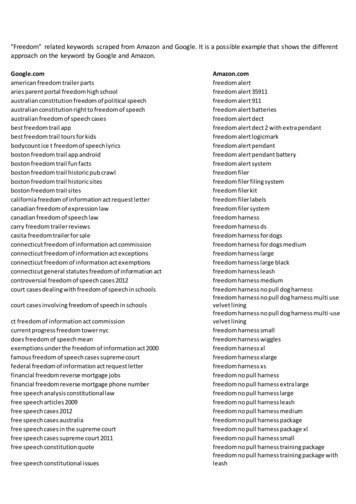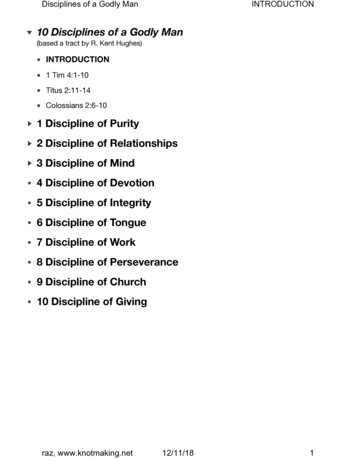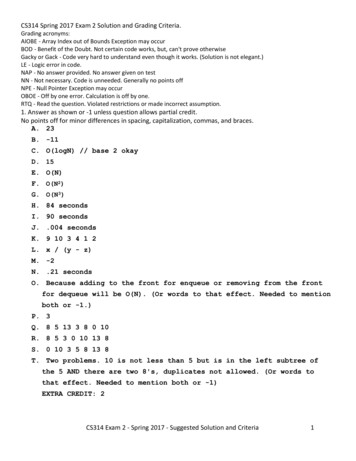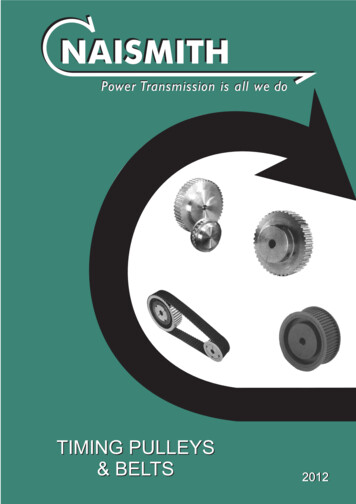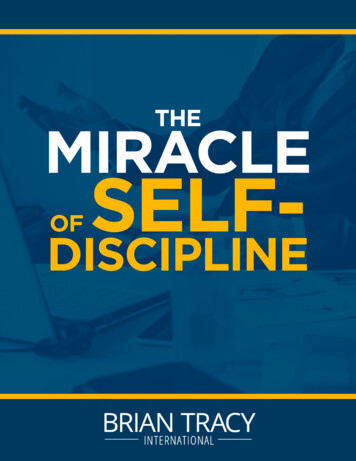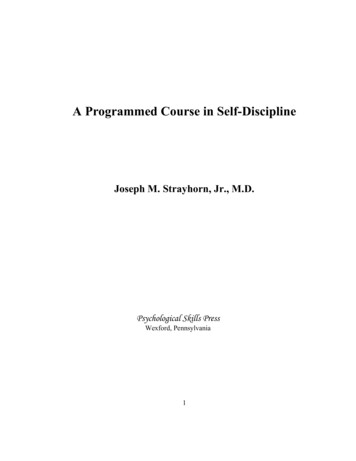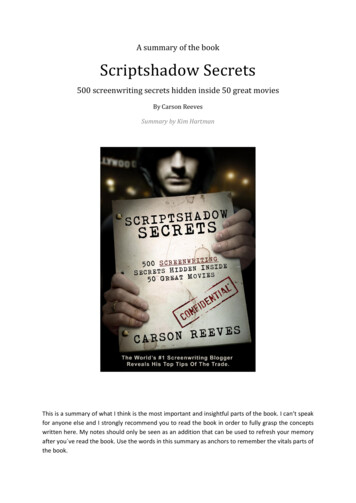
Transcription
Jocko Willink: Discipline EqualsFreedom Book SummaryWritten pline-equals-freedom-book-summary/YouTube Summaryhttps://www.youtube.com/watch?v MfOipBeM0EIAudio Podcast llow us on Instagram https://www.instagram.com/bestbookbits
Favourite Quotes"When do you start? You start right NOW. You initiate action. You GO.”"Stop researching every aspect of it and reading all about it and debating the prosand cons of it Start doing it.”"It takes both emotion and logic to reach your maximum potential, to really giveeverything you have, to go beyond your limits. Because emotion and logic will bothreach their limitations. And when one fails, you need to rely on the other.”"YOU DON’T NEED TO EAT.”"How do I handle those days when I’m just not “feeling it”? What do I do on thosedays? I GO ANYWAY. I GET IT DONE.""Don’t count on motivation. Count on Discipline.”"Power naps. They are real. If you are feeling tired they can be a lifesaver.”And my favourite, which is the conclusion to the book:“Don’t just read this book.Don’t just listen to the podcast.Don’t just watch videos online.Don’t just take notes.Don’t just study them.
Don’t just share them with your friends.Don’t just plan.Don’t just mark your calendar.Don’t just “get motivated.”Don’t just talk.Don’t just think.Don’t just dream.No. None of that matters.The only thing that matters is that you actually do.SO: DO"Part 1: ThoughtsOVERCOMING PROCRASTINATION: WHEN AND WHERE TO STARTPeople want to know how to stop laziness. They want to know how to stopprocrastination.“When is the best time to start?” And I have a simple answer: HERE and NOW.When do you start? You start right NOW. You initiate action. You GO.
YOU HAVE TO DO IT.And you have to do it now. So stop thinking about it. Stop dreaming about it. Stopresearching every aspect of it and reading all about it and debating the pros andcons of it Start doing it. Take that first step and Make It Happen. GET AFTER IT.HERE and NOW.THE PERSON YOU CAN CONTROLThe only person you can control is you. So focus on making yourself who you wantyou to be: Faster. Stronger. Smarter. More humble. Less ego. Discipline your body.Free your mind. Get up early, and go. Get after it and you will become the personyou want to be. And you become that person through: One. Small. Decision. At. A.Time.MIND CONTROLYou have control over your mind. You just have to assert it.You have to decide that you are going to be in control, that you are going to do whatYOU want to do. Weakness doesn’t get a vote. Laziness doesn’t get a vote. Sadnessdoesn’t get a vote.So next time you are feeling weak or lazy or soft or emotional, tell those feelingsthey don’t get a vote. You are declaring martial law on your mind: MIND CONTROL.Impose what you want on your brain: DISCIPLINE. POWER. POSITIVITY. WILL.And use that Mind Control to move your life where you want it to be: stronger,faster, smarter, quicker, friendlier, more helpful, more driven. Don’t let your mindcontrol you. Control your mind. And then you can: SET IT FREE.WEAKNESSI’m always fighting. I’m struggling and I’m scraping and kicking and clawing at thoseweaknesses — to change them. To stop them. Some days I win. But some days Idon’t. But each and every day: I get back up and I move forward. With my fists
clenched. Toward the battle. Toward the struggle. And I fight with everything I’vegot: To overcome those weaknesses and those shortfalls and those flaws as I striveto be just a little bit better today than I was yesterday STRESSHumans can withstand almost inconceivable stress — and you can too. So that isyour first step: Gain perspective. And to do that you must do something critical inmany situations: Detach.Whatever problems or stress you are experiencing, detach from them. Stress isgenerally caused by what you can’t control.If the stress is something that you can control and you are not, that is a lack ofdiscipline and a lack of ownership. Get control of it. Impose your will to make ithappen. Solve the problem. Relieve the stress. If the stress is something you can’tcontrol: Embrace it.You can’t control it, but —How can you look at it from a different angle? How can you use it to youradvantage?So. Don’t fight stress. Embrace it. Turn it on itself. Use it to make yourself sharperand more alert. Use it to make you think and learn and get better and smarter andmore effective.DESTROYER MODEWhere does the switch come from? The overdrive. The berserker mode. The full - ondestroyer that will not stop? I think this is something that is learned. And it is a hardlesson and not everyone gets it. And it is an important lesson. A critical one. It is thething that allows you to go the extra distance.And it actually takes two opposing forces to bring it to life. It takes both emotionand logic to reach your maximum potential, to really give everything you have, to go
beyond your limits. Because emotion and logic will both reach their limitations. Andwhen one fails, you need to rely on the other.When it just doesn’t make any logical sense to go on, that’s when you use youremotion, your anger, your frustration, your fear, to push further, to push you to sayone thing: I don’t stop. When your feelings are screaming that you have had enough,when you think you are going to break emotionally, override that emotion withconcrete logic and willpower that says one thing: I don’t stop. Fight weak emotionswith the power of logic; fight the weakness of logic with the power of emotion.And in the balance of those two, you will find the strength and the tenacity and theguts to say to yourself: I. DON’T. STOP.UNTIL THE ENDIt is never finished. You always have more to do. Another mission. Another task.Another goal. And the enemy is always watching. Waiting. Looking for that momentof weakness. Looking for you to exhale, set your weapon down, and close your eyes,even just for a moment. And that’s when they attack. So don’t be finished.Be starting. Be alert. Be ready. Be attacking. BE RELENTLESS.APPLICATION OF DISCIPLINEDiscipline starts with waking up early. It really does. But that is just the beginning;you absolutely have to apply it to things beyond waking up early. It is working out,every day, making yourself stronger and faster and more flexible and healthier. It iseating the right foods, to fuel your system correctly. It is disciplining your emotions,so you can make good decisions. It is about having the discipline to control yourego, so it doesn’t get out of hand and control you. It is about treating people the wayyou would want to be treated. It is about doing the tasks you don’t want to do, butyou know will help you. Discipline is about facing your fears so you can conquerthem. Discipline means taking the hard road — the uphill road.To do what is right. For you and for others. So often, the easy path calls us: To beweak for that moment. To break down another time. To give in to desire and short term gratification.
Discipline will not allow that. Discipline calls for strength and fortitude and WILL. Itwon’t accept weakness. It won’t tolerate a breakdown in will. Discipline can seemlike your worst enemy. But in reality it is your best friend. It will take care of youlike nothing else can.QUESTIONSWhich questions should you ask? Simple: Question everything. Don’t acceptanything as truth. QUESTION IT ALL.Question yourself every day. Ask yourself: Who am I? What have I learned? Whathave I created? What forward progress have I made? Who have I helped? What am Idoing to improve myself — today? To get better, faster, stronger, healthier,smarter?Is this what I want to be? This? Is this all I’ve got — is this everything I can give? Isthis going to be my life? Do I accept that?FIGHTGo down swinging. And I’ll tell you: If you fight with all you have, more often thannot, you won’t go down at all. You will win. But you have to make that attitude apart of your everyday life. Do the extra repetition. Run the extra mile. Go the extraround. Make the right choices. Give the full measure.COMPROMISEWhen working with other people and dynamic situations and relationships anddeals, a person, especially a leader, must compromise.And in many cases, a failure to compromise is a failure to succeed. But those areexternal compromises, with other people, other humans that have their ownpersonalities and ethos and issues. And compromise is needed to unify. So to workwith them, compromise is a must.But internally — it’s different. With myself, I have to hold the line. There are areaswithin myself where I CANNOT compromise. I am going to work hard. I am going to
train hard. I am going to improve myself. I am not going to rest on my laurels. I amgoing to own my mistakes and confront them. I am going to face my demons. I’m notgoing to give up, or give out, or give in. I’m going to stand. I am going to maintain myself - discipline.And on those points there will be No Compromise.DEFAULT AGGRESSIVEI view aggression as an internal character trait. A fire in your mind that says: I amgoing to win.NATURE VS. NURTUREWhat is more important: Nature or nurture? In my opinion: Neither.The people who are successful decide they are going to be successful. They makethat choice.And they make other choices. They decide to study hard. They decide to work hard.They decide to be the first person to get to work and the last to go home. Theydecide they are going to take on the hard jobs. Take on the challenges. They decidethey are going to lead when no one else will.And I will tell you something else: It is never too late to make that choice.So. Think not about what you’ve been through and where you were. Think aboutwhere you are going, and choose.FEAR OF FAILUREBut: I don’t want you to overcome fear of failure. I want you to be afraid of failure.But more important — I want you to be horrified — terrified — of sitting on thesidelines and doing nothing.SUGARCOATED LIES
Unless you have gone an extended period of time without food, you don’t need toeat. And you definitely don’t need to eat that poison. YOU DON’T NEED TO EAT.So. When those foods are tempting you, calling your name, and enticing you withtheir SUGARCOATED LIES — get angry. Get aggressive. Stand your ground in thebattle and fight by saying NO.BAD INSTINCTSThis is the instinct that says: YOU’VE HAD ENOUGH.Destroy that instinct. Replace it with the instinct that says: GET UP. GO. FIGHT ON.NOT FEELING ITHow do I handle those days when I’m just not “feeling it”?What do I do on those days? I GO ANYWAY. I GET IT DONE.Even if I am just going through the motions — I GO THROUGH THE MOTIONS.Now — these could be signals that you need some time off — and those signalsmight be right. BUT — don’t take today off. Wait until tomorrow. Don’t give in to theimmediate gratification that is whispering in your ear.REGRETAnd the most important thing to understand about regret is that in and of itself,regret is worthless. It does nothing for you. In fact: The only thing valuable in regretis the lesson you learned. The knowledge you gained.FOCUSI want that long-term goal to be so embedded in my mind, that I never lose sight ofit. EVER.Don’t do that. Embed that long - term goal in your mind. Burn it into your soul.Think about it, write about it, talk about it. Hang it up on your wall. But most
important: Do something about it. Every day. Every day: Do something that movesyou toward that goal — that keeps that goal alive and in sight and in focus.HESITATIONHESITATION IS THE ENEMY.To win, all you have to do is overcome that moment: The Waiting. The Hesitation.And to do that, all you have to do is: Go. Move. Take the action. Get out of bed. Getyour feet on the ground. Step forward. Do not hesitate. Do not wait. Go forward: Andwin.DRAW FIREBut that’s what I say: Draw fire. Bring that pain to me — I can handle it when otherscannot. When bad things are happening — I will be the one good thing — standingtall — that can be relied upon.GOODHow do I deal with setbacks, failures, delays, defeats, or other disasters? I actuallyhave a fairly simple way of dealing with these situations, summed up in one word: “Good. ”Take that issue, take that setback, take that problem, and turn it into somethinggood. Go forward. And, if you are part of a team, that attitude will spreadthroughout.DEATHInstead: Let us laugh and love and let us embrace and venerate everything that lifeis and every opportunity it gives us. Let us LIVE — for those WHO live no more. Letus live to honor them.EVERY DAYToday: I’m taking scalps. I’m putting the pressure on. I’m the aggressor. I’m on theattack.
But I will not Stop.NO MORENo more excuses. No more: “I’ll start tomorrow.” No more: “Just this once.” No moreaccepting the shortfalls of my own will. No more taking the easy road. No morebowing down to whatever unhealthy or unproductive thoughts float throu gh mymind.STAYING MOTIVATEDMotivation is fickle. It comes and goes. It is unreliable and when you are countingon motivation to get your goals accomplished — you will likely fall short.Don’t count on motivation. Count on Discipline.ME VERSUS MEBut my glory, it doesn’t happen in front of a crowd.It happens in the darkness of the early morning. In solitude.Where I try. And I try. And I try again. With everything I have, to be the best that Ican possibly be.Faster and stronger and smarter. And claim one victory that no one can ever takeaway from me. Ever. A victory that is earned every single day. A victory ofdetermination and will and discipline. A victory achieved because: I will not stop.REMAIN VIGILANTMost of us aren’t defeated in one decisive battle.We are defeated one tiny, seemingly insignificant surrender at a time that chipsaway at who we should really be.No. It is a slow incremental process. It chips away at our will — it chips away at ourdiscipline. We sleep in a little later. We miss a workout, then another.
You have to BE VIGILANT. You have to be ON GUARD. You have to HOLD THE LINEon the seemingly insignificant little things — things that shouldn’t matter — butthat do.FEARDon’t wait anymore. Don’t think anymore.Don’t plan anymore. Don’t contemplate anymore. Don’t make any more excuses orjustifications. Don’t rationalize anything else.Instead: Be aggressive. Take action. Now. And the first action you need to take? Thefirst step you need to take? The first step you need to take is just that: Step. Step. Go.Now.THE DARKNESSAs long as you keep fighting — you win. Only surrender is defeat. Only quitting isthe end.OVERWHELMEDYes. Life can be overwhelming.Line up those problems and confront them — face them — fight them.Instead, let these challenges raise you up — let them elevate you.So in the future, you look back at these struggles and you say to them: Thank you —you made me better.NEGATIVE TALK FROM NEGATIVE PEOPLEWhat do you do about the negative person talking behind your back and trying tobring you down?Ignore and outperform.
HOLD THE LINELive in defiance of the weakness and in rebellion against the decay.Do not surrender any ground. EVER.BEGINWhen the alarm sounds. IT IS TIME. Rise. Despite fatigue and soreness. Curse thewarmth of the bed. Curse the comfort of the pillow. Fight the temptation ofweakness. Get up and go.Do it quickly, without thought. Do not reason with weakness. You cannot. You mustonly take action. Get up and GO.ENGAGEI fight against fatigue and soreness and the weakness that says: Give in. I will notgive in. I will fight.LAUGHTER WINSTo spite the suffering. To spite the hardships. To spite the challenges. Laugh at themall.PART 2: ACTIONS PHYSICAL TRAINING: GETTING AFTER ITSTRESS: GOOD AND BADSo you have to be careful not to stress the body and mind too much. But again: YOUMUST STRESS THE BODY AND MIND SOME IN ORDER TO IMPROVE.WHEN?The biggest excuse not to work out is lack of time. Something always comes up. B utthere is one time of day that no can take away from you: predawn.
GET UP EARLY! This will be hard at first, but it will become normal. And once youare accustomed to it, early rising is guaranteed to make your day better. So GETAFTER IT.PSYCHOLOGICAL EDGEThere are a slew of psychological advantages that come from early morningphysical training. First, there is a psychological win over the enemy. Knowing thatyou are working harder than your adversaries gives you an advantage. It gives youconfidence that you can overcome them in battle. Another advantage to waking upearly and working out hard is that it demands discipline to do both.Before you go to bed, plan what workout you are going to do in the morning. Stageyour workout clothes so you don’t even have to think when you get up. Write downa list of things you need to accomplish the next day. Set your alarm clock for 4: 30a.m. and go to sleep.When the alarm clock goes off — get up. Put on your pre - staged clothes. Brushyour teeth and go get your workout on. Hard. Get done, shower, get dressed, andbegin to crush your list of tasks for the day.When it is time for breakfast, see what happens. You won’t want to eat junk.When you are on the path you want to stay on the path.Discipline begets discipline. Will propagates MORE WILL.SLEEPSleep is a necessity. Humans need sleep. Failure to get enough sleep has seriousside effects. But how much sleep is enough? Different people need differentamounts of sleep.For me, the condition I’m in and the cleaner I eat, the more quickly I will fall asleep,and the less sleep I need.
And finally, I choose not to sleep in. I don’t give in to the temptation of the warmblankets and soft pillow. I mobilize the will to get me out of bed and into the game.Obviously, I am an advocate of waking up early. But, since sleep must be a priorityto maintain health, how can we get enough sleep and still wake up early? Theanswer is simple: Go to bed earlier. Going to bed at 10 p.m. and waking up a t 5 a.m.gets you a solid seven hours.So, go to bed early, and wake up early. People constantly ask me for the secret ofgetting up early. I tell them it is simple: SET YOUR ALARM CLOCK AND GET OUT OFBED WHEN IT GOES OFF.Get up and get going. And one thing that will help you do that is going to bed earlier,which can be at least as hard, if not harder, than waking up.FALLING ASLEEPYes. It can be just as hard for some people to go to sleep early as it is to wake up —ifnot harder. So here are some steps to help that: 1. GET TIRED. 2. Turn off thecomputer. Turn off the smartphone. Stop checking social media and stop watchingone more YouTube video. 3. Read. 4. Most important: The key to getting to sleepearly is GETTING UP EARLY. No, it might not help you tonight but tomorrow night itwill. 5. Do it every day. People ask me if I still get up early on the weekends. YES.For a bunch of reasons. Obviously, the weekend is only two days so I want to get upand take advantage of it. The other reason I wake up early on weekends is to keepmy sleep pattern consistent. So: Don’t break the cycle. Get up early every day. If youneed extra sleep, take a power nap.POWER NAPSPower naps. They are real. If you are feeling tired they can be a lifesaver. And if youare feeling tired due to lack of sleep, they can be very powerful. I have a techniquefor power naps that is a combination of two things I learned.During those breaks, if I got the chance, I would lie down on the floor, put my feetup on my bed, set my alarm for six to eight minutes, and sleep. Of course, I wastired, so I would fall asleep very quickly, and when the alarm would go off, I wouldwake up and feel completely refreshed.
Warning: Be careful about letting your six- to eight-minute nap turn into a two-hourslumber. If you do this, you will have trouble falling asleep at night, which leads totrouble waking up in the morning.THE WORKOUTSAnd first of all—let me say this: The most important thing to do is SOMETHING.ANYTHING.Once you begin doing something, it is a good idea to track it. Recording weights,repetitions, and times is useful. The records allow you to track progress. They canserve as goals. They also let you know when you are overtraining. But, it isimportant to pay attention to your state at the end of a workout. The moreexperienced you become at working out, the easier this is. You will know when topush. You will know that there are days to hold back. My workouts are divided intosome broad types of movements: Pull, Push, Lift, Squat. In addition to those, theworkouts focus working the “Gut” and metabolic conditioning (MetCon). For thepurposes of this field manual, I have established three basic levels of exercises:Beginner, Intermediate, Advanced.To see the actual workouts, go to Appendix: The WorkoutsAgain, use the workouts as a guide. Learn about your own body. Push yourself. Mostimportant: Be consistent. And consistency starts with GETTING IN THE GYM. If youare tired or sore or burned out, don’t just give up completely. Go to the gym andstretch. Move. Do some light exercises. But keep the routine in place. Too often,people take the day off. And that turns into two. And two into three. And then theyhave gone a week without getting in a good workout. SO. Maintain the routine.Maintain the discipline.BUILDING THE HOME GYMOnce you have carved out some space, it is time to start getting equipment in place.Start with a pull-up bar.Another useful and relatively cheap piece of equipment is gymnastic rings.
Next up is a squat rack, which should include a pull-up bar and some kind of dip barattachment. With the squat rack, a barbell and weights are needed. Rubber bumperplates allow for dynamic lifts like the clean and jerk and the snatch. That’s it. That’sall you need.That basic setup should go a long way in achieving exceptional fitness. Beyond thatthere are countless implements to include in your arsenal when time and budgetallow. Kettlebells are probably the next addition, then a rowing machine and/or anair bike. A Glute-Ham Developer (GHD) is another piece of equipment that isdefinitely nice to have at home. Medicine balls, plyometric boxes, bands, chains, clubbells, sledgehammers are also fun to use. But, while all those pieces of equipmentare nice to have and can add some variety to training, none of them are reallynecessary, and although I have all those in my gym, I still most consistently use thebasic equipment: pull-up bar, dip bars, rings, squat rack, and barbell with bumperplates.MARTIAL ARTSEveryone should train in martial arts, just as everyone should eat.There are three broad forms of martial arts: grappling, striking, and weapons.Grappling uses leverage and holds to control or submit your opponent. Striking usespunches, kicks, knees, elbows, headbutts, and any other body parts to hit theopponent. Martial arts with weapons obviously utilize a variety of weapons,including sticks, knives, and, in the modern world, firearms. Perhaps the mostcritical form of self-defense is the mind. By being smart and aware, you can avoidsituations that are likely to expose you to danger.Of course, mishandled firearms are extremely dangerous and can cause seriousinjury and death to the owner or other innocent people if they are not handled withthe four principles of firearm safety constantly in mind: 1. Treat every gun as if it isloaded. 2. Never point your gun at something you are not willing to destroy. 3. Keepyour finger off the trigger until your sights are on target. 4. Always be sure of yourtarget and what is behind it. Additionally, firearms should always be stored in a safeplace where they cannot fall into the wrong hands. Most important, without propertraining, possessing a firearm is useless, or even more dangerous to its owner than
not having one. Learning how to shoot quickly and accurately while under stress isabsolutely mandatory if one is going to own a firearm.So, here are my recommendations on which martial arts to learn and how toproceed down the path of learning martial arts. Start with Brazilian jiu-jitsu. Ourfirst form of self-defense is to get away—yes, run. If you are confronted by anotherperson or a group of people, the best thing you can do is run away: avoid theconflict.Another reason I recommend starting martial arts by learning Brazilian jiu-jitsu isbecause it is the most complex of the martial arts. Due to this unending depth in jiujitsu, it is also the most cerebral of the martial arts. It provides incredible mentalstimulus and a never-ending challenge to learn, develop, and improve.The next martial art I recommend learning is boxing. Boxing is an incrediblyeffective striking art despite its relative simplicity: There are only two weapons inboxing—the left hand and the right hand. But with those two weapons, anincredible advantage can be gained if you know how to throw them in effectivecombinations. Other critical elements learned in boxing are angles, movement (bothof which are based heavily on footwork), and speed, which are utilized in both theoffense and defense of boxing.The next two martial arts to invest time into are Muay Thai and wrestling. Theyboth add a plethora of options and skills to any fighter. Muay Thai adds a massivearsenal of striking options to a fighter. Where boxing utilizes only the fists, MuayThai utilizes the fists, the elbows, the knees, and the shins in very aggressivecombinations that are absolutely devastating in a fight. Muay Thai is also about painand the ability to withstand pain.Wrestling is a grappling art, perhaps the most widely known and practiced. It is anamazing sport for conditioning of both the mind and the body. The physical grind ofwrestling hardens the body and mind without mercy. On top of the conditioning andmental toughness derived from wrestling, it is also king of position in martial arts—meaning a good wrestler can decide what position they will be in during aconfrontation. No other martial art provides the practitioner a better ability to
dictate the position of a fight with one simple idea: The main focus of wre stling is toget an opponent to the ground and keep them there.In areas where there might not be any Brazilian jiu-jitsu schools, judo is the nextbest replacement.There are other martial arts that can be good to look into such as Krav Maga andSystema, both of which focus on self-defense as its primary mission. Martial artslike Escrima and Kali from the Philippines, also known as Arnis, which focus onfighting with sticks and knives. Also, the Dog Brothers have pushed the limit in fullcontact weapons sparring—and in that effort have garnered real-world knowledgebeyond what was previously available. The list could go on and on. There is noreason to ever stop training and learning martial arts. Of course, it is good to beprepared to handle a self-defense situation, but the benefits of martial arts traininggo far beyond self-defense.So train. Don’t think about it. Don’t take time to “get in shape” before you start . Justgo start. The rest will come WHERE TO TRAINWhen picking a good jiu-jitsu academy, first things first: Find some schools that arein your immediate area. Proximity is important. The more convenient it is to get totraining, the more often you will be able train.Once you have identified some academies close by, go and pay a visit. Theatmospheres in gyms can vary greatly. Some are very traditional, demand matchinguniforms, bowing to instructors and to the mat, and are run in a very rigid manner.Other schools do not operate with that tradition. There is no bowing. A wide varietyof uniforms can be seen on the mat.Also, don’t just show up and watch. Bring your gear and participate. Evaluate theclass. How was it taught? What was the attitude of the instructor and the otherstudents? Talk to the students. What are their goals? Are their goals similar toyours? Was there much ego on the mat? Did anyone try to rip your head off? Whatabout the instructor? Depending on where you live the instructor may or may notbe a black belt. While a black belt instructor is optimal, some areas of the world just
don’t have any. That’s okay. A brown belt or a purple belt can give great instructionas well. There can be some concern about the legitimacy of the lineage of theinstructor as well. Luckily, the internet has solved most of that.Also, with regard to the instructor, remember jiu-jitsu is not a religion and a jiujitsu instructor is not a god. So, while they deserve respect, just as any other persondoes, they should give respect as well—even to brand-new white belt students. Jiujitsu should not feel like a cult—at all. Bottom line, jiu-jitsu should be fun, friendly,and engaging. You should look forward to going to jiu-jitsu because you know youwill get pushed mentally and physically. While jiu-jitsu will absolutely be humbling,tiring, and frustrating, if you don’t enjoy it, you are either letting your ego get in theway, or you are in the wrong school.IMMEDIATE ACTION DRILLS: FACING A THREATObviously, training is the best way to prepare to face threats. But there is adifference between a training scenario at the gym or at the range and a realconfrontation on the street. How can you be ready for that? And how should youreact? The first thing to do is train. Train hard. Train for worst-case scenarios. Trainfor things to go wrong by putting yourself in horrible training situations and findingyour way out of them. The next most important concept is avoidance. Yes. Avoid thedanger. Stay away from high-threat areas.So it is important to maintain situational awareness at all times. Pay attention toyour surroundings. Look at suspicious people. Look at unsuspicious people. Whatare they doing? Where are they going? What are they looking at? Assess. While youassess, think of contingencies. Where is your closest escape route? Where is theclosest cover and concealment—“cover” being a place to shield you from bullets and“concealment” being a pla
Don't just share them with your friends. Don't just plan. Don't just mark your calendar. Don't just "get motivated." Don't just talk.

